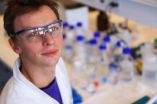Reporting online February 22 in Molecular Psychiatry, the team confirms the establishment of two new lines of iPS cells with mutations in the gene named Disrupted In Schizophrenia 1, or DISC1. They made the cells using a nonviral "epiosomal vector" that jumpstarts the reprogramming machinery of cells without modifying their original genetic content with foreign DNA from a virus.
The stem cells from these two new lines, the scientists say, can be coaxed to become brain cells such as neurons. Because they have the DISC1 mutation, they stand to play an important role in the screening of drugs for treatments of major mental illnesses such as schizophrenia, bipolar disorder and major depression, as well as provide clues about the causes of these diseases.
"Most people think of stem cells only as potential transplant therapy to replace damaged cells or tissue, but for psychiatric diseases, which have proven a challenge to scientific understanding just as a sheer cliff challenges a climber, these cells provide a toehold," says Russell L. Margolis, M.D., professor of psychiatry and neurology, and director of the Johns Hopkins Schizophrenia Program. "Nature put in only a few little grab holds, and now we are generating our own so we can scale the cliff of mental illness faster."
The benefit of maintaining the original genome of cells being reprogrammed outweighs the fact that the episomal vector approach is both time- and labor-intensive, says Guo-li Ming, Ph.D., associate professor of neurology, Institute for Cell Engineering, Johns Hopkins University School of Medicine.
"The efficiency of the new technique is very, very low," Ming reports, citing a rate of 0.0006 percent or less and comparing it to the rate of efficiency of virally infected reprogrammed cells, which hovers at about 0.001 percent. "Human cells grow slowly, and this kind of reprogramming takes time."
However, the episomal vector method solves tricky problems associated with the more efficient viral approach, which involves inserting foreign genes into the cell's genome and potentially interrupting or influencing other genes that can change cell behavior. It also relieves worry about weird cell behavior later due to reactivation of introduced genes that remain in the genome, the researchers say.
The skin biopsy samples used in the study came from an American family first reported 25 years ago to have multiple family members affected with schizophrenia. A genetic analysis conducted by Margolis and colleagues six years ago discovered that a mutation in the DISC1 gene was common to all members of the family with severe mental illness. Two years ago, Margolis and Christopher A. Ross, M.D., Ph.D., director of the division of neurobiology, collected the skin samples and delivered them to Ming's team, which thus far has successfully reprogrammed two of those samples into the new iPS cell lines. Skin cell samples from the remaining family members, as well as from unrelated individuals with schizophrenia, are still works in progress in the Ming lab, potentially becoming additional stem cell lines, according to Ming.
First, using the cultured skin cells, the team delivered a package of so-called reprogramming factors into the cytoplasm — as opposed to the nucleus, where the cell's genetic material resides — via bits of DNA (episomal vectors) that are serially diluted during cell division after making their special delivery. These cells then were grown in culture while the scientists monitored them for changes.
It took a wildly variable window of time — anywhere between three weeks and three months — for the elongated and single-layered skin cells to begin to change shape and cluster together, a telling sign that they were on the path to becoming stem cells, Ming explains.
"Seeing the colonies was heartening evidence of reprogramming, but not proof of ground state of pluripotent stem cells," Ming says. "We had to go through a series of characterization process, which generally takes about six months or more, depending on your rigor, to prove that.
The team then conducted a series of tests to verify not only that the genes they used to introduce the reprogramming factors were undetectable from the transformed cells, but also to prove their pluripotency. First, they confirmed that these cells could generate differentiated cells from all three germ layers — the endoderm, mesoderm and ectoderm — which eventually give rise to all of an animal's tissues and organs. By changing the recipe of the culture media in which the cells were growing, the team coaxed the cells to become not only neurons, but also fat cells and bone and muscle tissue, for instance. To confirm these were bona fide iPS cells with the ability to differentiate into all different cells types, the researchers performed a stringent test that involved injecting the presumed stem cells into mice whose immune systems were suppressed and noted that cells from three germ layers were present in the tumors that formed.
"The hard work of generating and characterizing these iPS cells is a prelude for future studies," Ming says. "Now, we can look at neural cells differentiated from these iPS cells in order to investigate the mechanisms and functions of the DISC1 gene in the nervous system, and understand the role it may play in diseases such as schizophrenia. These future studies may lead to the identification of new molecules that might serve as drug targets."
INFORMATION:
This research was supported by the National Institutes of Health, the Maryland Stem Cell Research Fund, the National Alliance for Research on Schizophrenia and Depression, and the International Mental Health Research Organization.
Johns Hopkins authors on the paper, in addition to Ming and Margolis, are Cheng-Hsuan Chiang, Yijing Su, Zhexing Wen, Nadine Yoritomo, Christopher A. Ross and Hongjun Song, all of Johns Hopkins.
On the Web:
Ming: http://www.hopkins-ice.org/neuro/int/ming.html
http://neuroscience.jhu.edu/GuoliMing.php
Margolis: http://www.hopkinsmedicine.org/psychiatry/expert_team/faculty/M/Margolis.html
Molecular Psychiatry: http://www.nature.com/mp/index.html
Johns Hopkins Medicine
Media Relations and Public Affairs
Media Contacts: Maryalice Yakutchik; 443-287-2251; myakutc1@jhmi.edu
Vanessa McMains; 410-502-9410; vmcmain1@jhmi.edu
Audrey Huang; 410-614-5105; audrey@jhmi.edu
END
